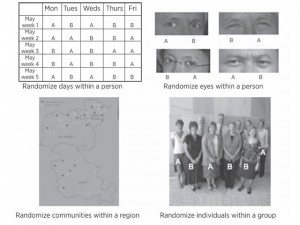Ways of using unbiased (random) allocation in treatment comparisons
Ways of using unbiased (random) allocation in treatment comparisons
Random allocation for treatment comparisons can be used in various ways. For example, it can be used to compare different treatments given at different times in random order to the same patient – a so-called ‘randomized cross-over trial’.
So, to assess whether an inhaled drug could help an individual patient with a persistent, dry cough, a study could be designed to last a few months. During some weeks, chosen randomly, the patient would use an inhaler containing a drug; during the other weeks the patient would use an identical-looking inhaler which did not contain the drug.
Tailoring the results of research to individual patients in this way is clearly desirable if it can be done. But there are many circumstances in which such crossover studies are simply not possible. For example, different surgical operations cannot be compared in this way, nor can treatments for ‘one-off’, acute health problems, such as severe bleeding after a road crash.

Different possible units for random allocation (click to enlarge)
Random allocation can also be used to compare different treatments given to different parts of the same patient.
So, in a skin disorder such as eczema or psoriasis, affected patches of skin can be selected at random to decide which should be treated with ointment containing a drug, and which with ointment without the active ingredients. Or in treating illness in both eyes, one of the eyes could be selected at random for treatment and comparison made with the untreated eye.
Another use of random allocation is to compare different treatments given to different populations or groups – say, all the people attending each of a number of primary care clinics or hospitals. These comparisons are known as ‘cluster (or group) randomized trials’.
For example, to assess the effects of the Mexican universal health insurance programme, researchers matched 74 pairs of healthcare catchment areas – clusters that collectively represented 118,000 households in seven states. Within each matched pair one was allocated at random to the insurance programme. [6]
However by far the most common use of random allocation is its use to decide which patient will receive which treatment.

